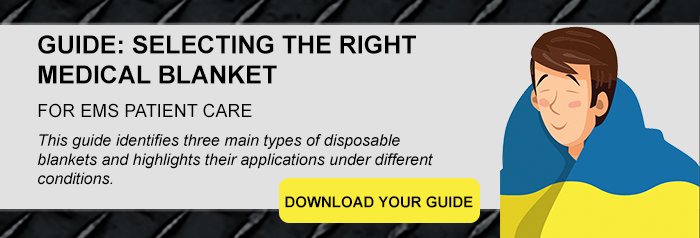The Basics 
Like most EMT and paramedic professionals you probably have a good grasp of how hypothermia in the field can adversely affect the outcome of the patient in traumatic shock; but often the imperative to provide fluid resuscitation, hemostasis, and CPR becomes your more overriding concern.
Recognizing this, it is important to emphasize that medical science has long understood that something as simple as maintaining a normothermic core temperature for the trauma patient must occupy a place of equal importance to other lifesaving measures.
Hypothermia
The generally accepted definition of hypothermia is a core temperature of
Deadly Outcomes
Perhaps counterintuitively, the adverse effects of hypothermia are much worse in trauma patients than in exposure victims. This 2004 study by Tsuei and Kearney cited a 100% mortality rate among trauma victims whose core temperature drops to 32 degrees as opposed to 21% mortality for
How it Happens
Hypothermia in the trauma patient may come about by some obvious mechanisms such as blood loss, environmental exposure, alcohol ingestion, and traumatic brain injury, which impairs the body’s ability to self-regulate temperature or activate the compensatory shivering reflex.
Less obviously, the use of room temperature IV crystalloid fluids, advanced or
Recognizing the Problem
You must be vigilant in identifying traumatic hypothermia when you see it. Some of the obvious and not-so-obvious signs of heat loss include:
- Shivering, which may or may not be present in the injured patient
- Mottled appearance of skin
Rapid heart rate that eventually begins to slow- Mental status changes marked by confusion and poor judgment
- Rapid respirations that unaccountably begin to slow
In an emergency situation, some of these signs will not be clear-cut. For example, as indicated above, an injured person may not exhibit shivering until their core temperature is well below that of an uninjured shivering subject.
For those reasons, hypothermia in the trauma patient must be assumed unless ruled out. Beyond physical signs, a more objective means of identifying hypothermia should be included in the patient assessment.
Oral, rectal and bladder measurements can be inconsistent, as can tympanic membrane measurements as well. More important than a discreet single measurement is
Interventions
Here are some easily invoked interventions to help avoid hypothermia in the trauma victim.
- Use warmed IV fluids - when possible
- Remove wet clothing
- Apply thermal blankets specifically designed to counteract the effects of hypothermia
- Polyester, fleece or cotton blankets polyvinyl/tissue covers
- Mylar heat reflective wraps
Many of these ideas are simple, straightforward, non-invasive and require no special technical knowledge. The next time you think that you have exhausted all of the lifesaving techniques for your trauma victim, please remember that one of the most important things you can do is also the simplest. It means going that extra mile to wrap the patient in a blanket to preserve vital body heat and maybe save a life.
At Graham Medical, we not only make MegaMover® Transport Units, but we also provide an extensive line of single-use blankets for pre-hospital patient care. Contact us here for a free sample or call us at 800-558-6765.

